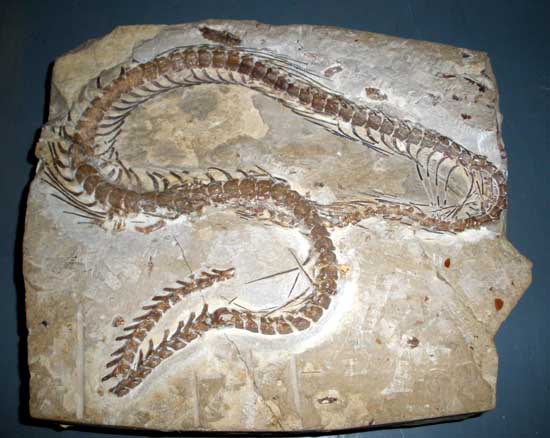Why snakes do not have legs?
Snakes used to have full legs like many other species, but this part disappears because it is not suitable for the environment.

Fossil snake species Eupodophis descouensi
If not all, at least some snakes have also had their legs in the early stages of evolution. However, they have lost their expenditure over time, according to a recent report of the National Museum of Natural History in Paris (France). The study strengthens the theory that snakes evolved from a lizard that once lived in a cave in the land or swam in the sea, according to the Journal of Vertebrate Paleontology .
To draw this conclusion, research leader Alexandra Houssaye and colleagues analyzed fossils of snakes called Eupodophis descouensi. This prehistoric snake once appeared in the Cretaceous region in the area now Lebanon. In order to better understand the special specimen, scientists used a new simulation method called tomography on synchrotron radiation (SRCL) computer. This is a method for capturing thousands of 2-dimensional images from within the template. The images were further rendered into a 3-dimensional model, clearly showing the hips of the snake and the small legs only 2 cm long.
With a new 3-dimensional model, experts discovered that Eupodophis used to own 2 hind legs carrying signs of gradual deterioration and no previous expenditure. The posterior limbs also have knees and 4 ankle bones, but no foot bones or finger bones. Thanks to SRCL, they identified the snake's leg bone very similar to the modern lizard.
Scientist Houssaye said that he had lost all of his legs to match the scene of snuggling in deep caves or swimming in the ocean. Evidence is that the legs in the fossil record are severely degraded and their descendants have no legs. Eupodophis is also not the oldest snake in the world. ' The oldest snake ever discovered by humans dates from 112 to 94 million years ago, and this snake lived about 90 million years ago, ' Houssaye said. Najash rionegrina, a snake that also lived in the same period as Eupodophis is believed to have two small legs behind. Najash was discovered by experts at the University of Sao Paulo (Brazil) in the province of Rio Negro in Argentina.
- This is why snakes don't have legs
- The first snakes in the world can ever have legs
- Millions of years ago snakes once had hips
- Poisonous snakes in Vietnam
- The truth about 11 extremely poisonous snakes in the world
- Strange little known about snakes
- How many legs does a rolling roller really have?
- 7 snakes look scary ... but harmless to humans
- Find a new snake, but no one can find it
- Mysterious answers about snakes and canines
- How to distinguish poisonous snakes and non-toxic snakes
- Discovering a unique hunting technique of snakes
 'Fine laughs' - Scary and painful torture in ancient times
'Fine laughs' - Scary and painful torture in ancient times The sequence of numbers 142857 of the Egyptian pyramids is known as the strangest number in the world - Why?
The sequence of numbers 142857 of the Egyptian pyramids is known as the strangest number in the world - Why? History of the iron
History of the iron What is alum?
What is alum?